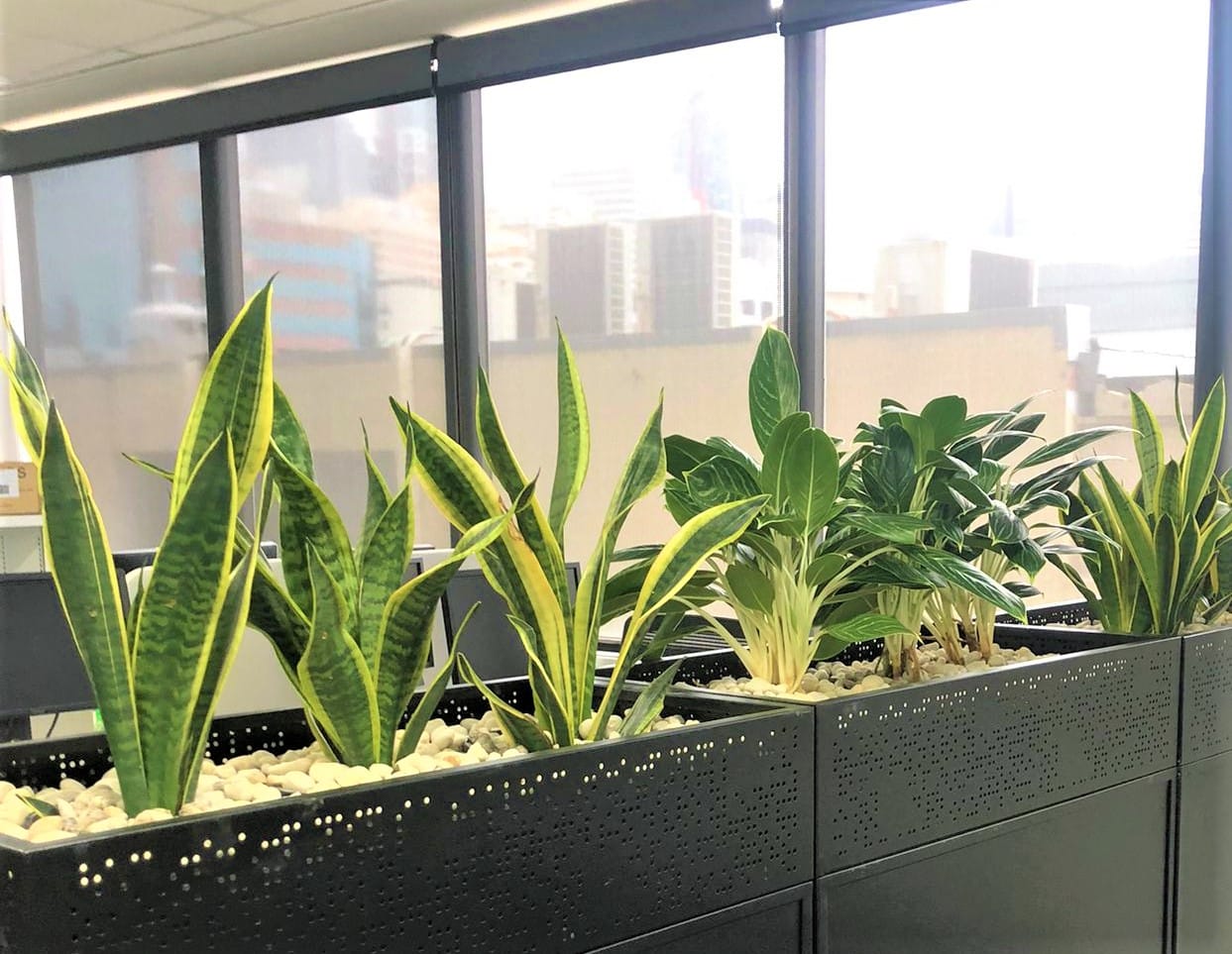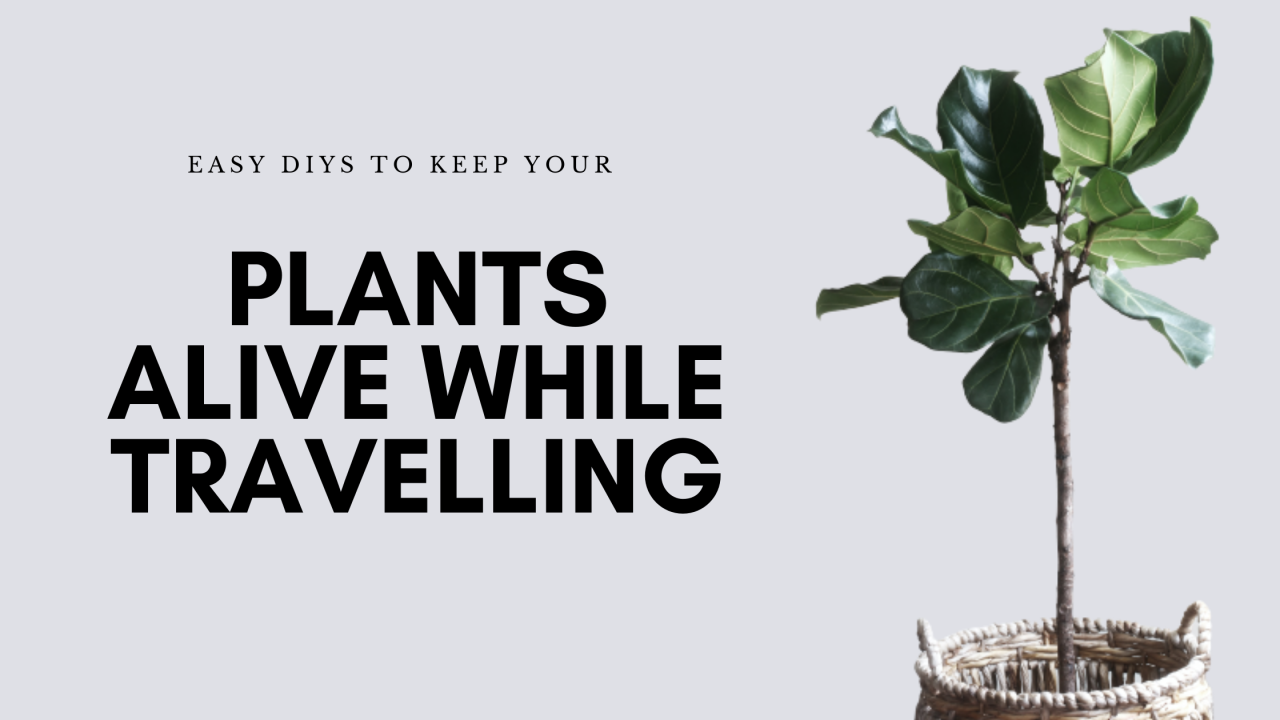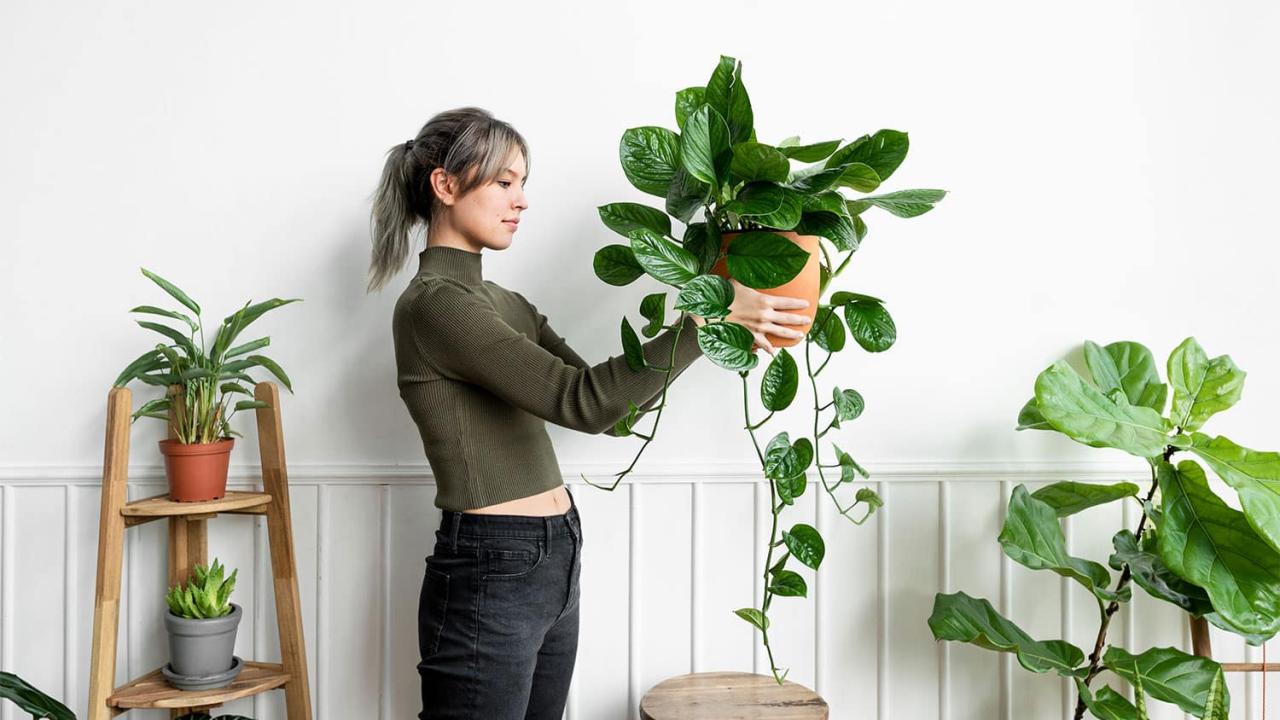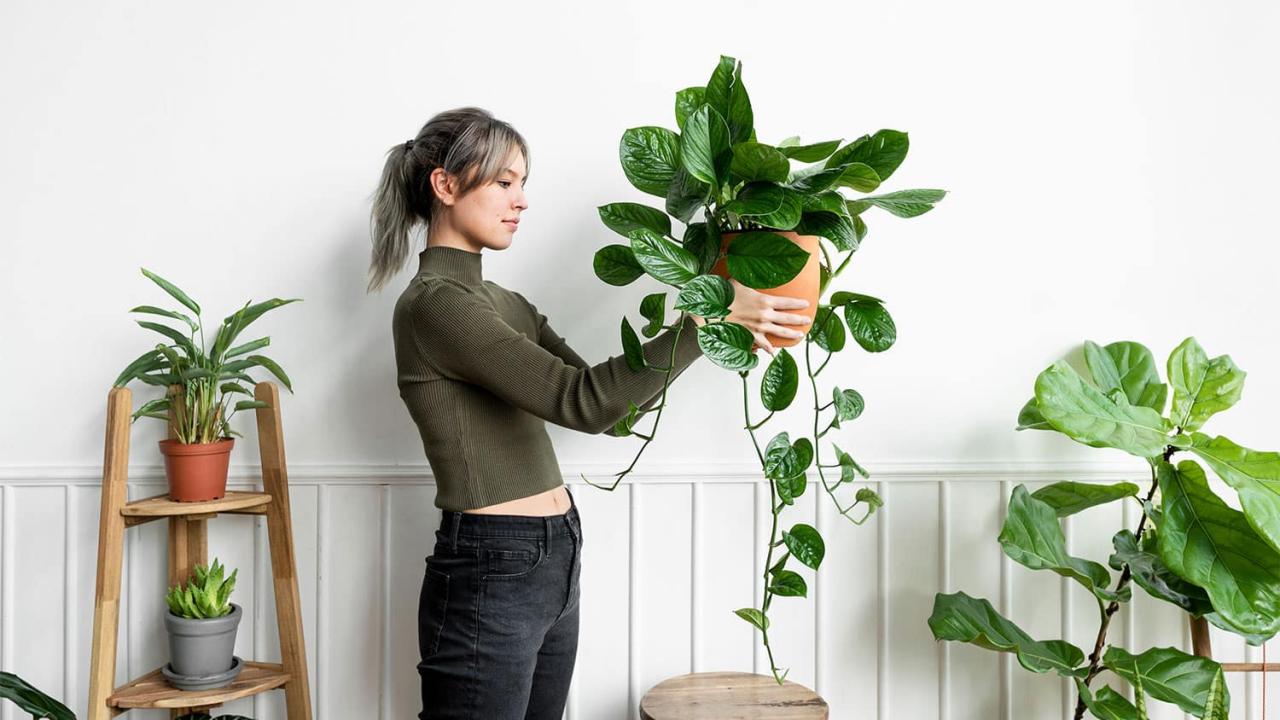How to Keep Hanging Plants Alive During Vacation is a question many plant parents grapple with when planning a getaway. Leaving your beloved greenery unattended can be a source of anxiety, but with the right strategies, you can ensure your hanging plants thrive even while you’re away.
This guide explores various watering methods, plant selection tips, and environmental considerations to help you create a vacation-proof plan for your hanging plant collection.
From self-watering systems and thorough soil soaking to choosing drought-tolerant varieties, this article provides practical advice and solutions to keep your hanging plants healthy and vibrant throughout your absence. We’ll also delve into the importance of pre-vacation preparation, including a checklist of tasks to ensure your plants are ready for extended periods without your care.
Furthermore, we’ll address common troubleshooting tips and maintenance strategies to help you navigate any challenges that may arise.
Watering Methods
Keeping your hanging plants hydrated while you’re away can be a challenge, but with a little planning and the right techniques, you can ensure your leafy companions thrive. Here’s a breakdown of different watering methods for keeping your hanging plants alive during your vacation:
Self-Watering Systems, How to Keep Hanging Plants Alive During Vacation
Self-watering systems offer a convenient way to provide consistent moisture to your plants while you’re gone. These systems typically consist of a reservoir that holds water and a wick or other mechanism that draws water up to the soil.
- Pros:Self-watering systems are generally low-maintenance and can provide consistent moisture for extended periods, making them ideal for longer vacations. They are also effective for a variety of plant types.
- Cons:Self-watering systems can be more expensive than other methods, and they may not be suitable for all plant types. Some plants may prefer more frequent watering or have specific soil requirements that these systems may not meet.
Here are some examples of readily available self-watering systems:
- Terracotta Pots with Self-Watering Inserts:These pots come with a built-in reservoir and a wick that draws water up to the soil. They are suitable for most houseplants, including hanging plants.
- Hanging Planter with Reservoir:These planters feature a built-in reservoir that can hold a significant amount of water, providing a consistent supply to your hanging plants. They are particularly useful for larger plants that require more moisture.
- Self-Watering Globes:These globes are filled with water and placed into the soil. The water slowly seeps out through the globe, providing moisture to the plant’s roots. These globes are effective for small to medium-sized plants.
Soaking the Soil Thoroughly Before Departure
Thoroughly soaking the soil before you leave is a simple and effective method for keeping your plants hydrated for a short period.
- Pros:This method is cost-effective and requires minimal effort. It is suitable for plants that don’t require frequent watering.
- Cons:This method is only effective for short vacations, typically up to a week. If your vacation is longer, the soil may dry out completely, leading to plant stress or even death.
Using a Plant Mister
A plant mister can help to maintain humidity around your hanging plants, particularly if they are susceptible to drying out.
- Pros:Misting is a simple and affordable method that can help to increase humidity around your plants. It is especially useful for plants with delicate foliage that are prone to drying out.
- Cons:Misting alone is not sufficient to provide adequate moisture to the soil. It is best used in conjunction with other watering methods. Additionally, excessive misting can lead to fungal growth, so it is important to ensure good air circulation around your plants.
Employing a Drip Irrigation System
Drip irrigation systems are designed to deliver water directly to the plant’s roots, minimizing water waste and ensuring consistent moisture.
- Pros:Drip irrigation systems are highly effective for providing consistent moisture to your plants. They are particularly useful for longer vacations and can be customized to meet the specific needs of your plants.
- Cons:Drip irrigation systems can be more expensive than other methods, and they may require some initial setup. Additionally, they may not be suitable for all plant types, as some plants prefer more frequent watering or have specific soil requirements.
Plant Selection

Choosing the right hanging plants is crucial for a successful vacation-proof garden. Opting for species known for their drought tolerance and low-maintenance needs will ensure your greenery thrives even in your absence.
Low-Light Tolerance and Water Needs
Selecting plants that can adapt to low-light conditions and infrequent watering is essential for vacation-ready hanging baskets. Many plants can flourish with minimal sunlight and occasional watering, making them ideal for homes with limited natural light or busy schedules.
Keeping hanging plants alive while you’re away on vacation can be a challenge, but with a little planning, it’s achievable. One crucial aspect is avoiding common watering mistakes, such as overwatering or underwatering. To ensure your plants thrive while you’re gone, it’s essential to understand the 5 Mistakes to Avoid When Watering Hanging Plants.
This knowledge will help you create a watering schedule that keeps your hanging plants happy and healthy even while you’re away.
- Spider Plants (Chlorophytum comosum):These resilient plants tolerate low-light conditions and can handle some neglect. They prefer indirect light and infrequent watering, making them a perfect choice for vacation-proof hanging baskets.
- Cast Iron Plant (Aspidistra elatior):Known for its hardiness, the cast iron plant can withstand low-light conditions and infrequent watering. It is also tolerant of a wide range of temperatures, making it a reliable choice for various environments.
- ZZ Plant (Zamioculcas zamiifolia):This low-maintenance plant is incredibly drought-tolerant and can thrive in low-light conditions. Its ability to store water in its leaves makes it perfect for situations where watering might be inconsistent.
Environmental Considerations
Hanging plants, with their aerial roots and delicate foliage, are particularly susceptible to changes in their environment. Vacation periods often bring disruptions in care routines, making it crucial to consider how environmental factors can impact their well-being. Understanding how sunlight, temperature, and humidity affect these plants can help you minimize stress and ensure their survival during your absence.
Sunlight Exposure
Sunlight is essential for photosynthesis, but excessive exposure can lead to scorching and wilting. During your vacation, the intensity and duration of sunlight can fluctuate, potentially stressing your plants.
- Adjusting Plant Location:Before leaving, assess the amount of sunlight your hanging plants receive. If your home is prone to excessive sun during the day, consider moving them to a shadier location, like a room with filtered light or a porch with morning sun only.
Heading off on vacation and worried about your hanging plants? While ensuring their survival might seem like a challenge, it’s a task that’s been tackled for centuries. The popularity of hanging plants, as explored in The History of Hanging Plants and Their Popularity , stems from their ability to add vertical greenery and a touch of nature to any space.
Fortunately, with a little planning and the right care, your hanging plants can thrive even while you’re away, adding a welcome burst of life upon your return.
- Providing Shade:If moving the plants isn’t feasible, create temporary shade using sheer curtains, blinds, or even a lightweight fabric draped over the plant.
Temperature and Humidity
Extreme temperatures and humidity fluctuations can be detrimental to hanging plants. High temperatures can cause dehydration and wilting, while low humidity can lead to dry leaves and stunted growth.
- Using Fans:During periods of high heat, strategically placed fans can circulate air, promoting evaporation and cooling the surrounding environment.
- Humidifiers:If your home is prone to dryness, consider using a humidifier to maintain a comfortable humidity level.
Monitoring and Adjustments
Before departing for your vacation, take time to carefully assess your plants’ environment.
- Sunlight:Observe the amount of direct sunlight they receive throughout the day.
- Temperature:Monitor the temperature in the room where your plants are located.
- Humidity:Check the humidity levels using a hygrometer or simply by observing the leaves for signs of dryness.
Pre-Vacation Preparation

Preparing your hanging plants for an extended absence requires proactive measures to ensure their well-being. By taking the time to adequately prepare, you can minimize the risk of your green companions wilting or succumbing to pests while you’re away.
Thorough Watering
Prior to your departure, it’s crucial to thoroughly water your hanging plants. This provides them with a substantial water reserve to sustain them during your absence. The amount of water required will vary depending on the plant species and the size of the hanging basket.
- Soak the soil completely: Ensure the water penetrates the entire root ball, allowing the soil to absorb the moisture fully.
- Allow excess water to drain: After watering, allow any excess water to drain out of the drainage holes in the hanging basket. This prevents waterlogging and root rot.
- Consider the pot size: Smaller pots will dry out faster than larger ones.
Pruning Dead or Wilting Leaves
Removing any dead or wilting leaves before your departure helps conserve the plant’s energy and minimizes the risk of fungal growth or pests.
- Identify and remove dead or wilting leaves: Carefully inspect your plants and prune away any leaves that appear brown, yellowed, or withered.
- Use clean, sharp tools: Ensure you use clean, sharp pruning shears or scissors to minimize damage to the plant.
- Dispose of pruned leaves properly: Discard the pruned leaves in a compost bin or trash bag to prevent the spread of diseases.
Pest and Disease Inspection
Checking for pests or diseases before your trip allows you to address any issues promptly and prevent them from spreading.
- Inspect for common pests: Look for signs of aphids, mealybugs, spider mites, or scale insects.
- Examine for disease symptoms: Check for signs of fungal diseases, such as powdery mildew or leaf spots.
- Treat any infestations or diseases: If you find any pests or diseases, treat them before you leave. Use appropriate insecticides or fungicides according to the manufacturer’s instructions.
Supporting Hanging Baskets
Ensure the hanging baskets are securely attached and adequately supported to prevent them from falling or becoming damaged during your absence.
- Reinforce hanging hooks: Double-check the hooks or hangers supporting the baskets to ensure they are securely fastened and can withstand the weight of the plants.
- Consider additional support: If the baskets are particularly heavy or are in a windy location, consider adding extra support, such as a rope or chain, to further secure them.
- Protect from potential damage: If the baskets are positioned near areas prone to damage, such as doorways or walkways, consider moving them to a safer location.
Pre-Vacation Checklist
To ensure your plants are well-prepared for your absence, create a checklist to guide your preparation.
- Thoroughly water all hanging plants: Ensure the soil is completely soaked.
- Prune any dead or wilting leaves: Remove them to conserve energy and prevent disease.
- Inspect for pests and diseases: Treat any infestations or diseases promptly.
- Reinforce hanging hooks and supports: Ensure the baskets are securely attached and supported.
- Consider a plant sitter: If you’re going on an extended vacation, consider asking a trusted friend or neighbor to check on your plants while you’re away.
Remote Monitoring
If possible, set up a system to remotely monitor your plants while you’re away.
- Install security cameras: Place cameras in strategic locations to provide visual monitoring of your plants. This allows you to check on their condition remotely and identify any potential issues.
- Utilize smart home devices: Consider using smart home devices, such as humidity sensors or automated watering systems, to monitor and adjust the environment for your plants.
- Connect with a plant sitter: If you have a plant sitter, provide them with access to your remote monitoring system so they can check on your plants and provide updates.
Troubleshooting and Maintenance

Even with the best preparation, unforeseen issues can arise with your hanging plants while you’re away. It’s crucial to be aware of common problems and have a plan to address them, either remotely or upon your return. Regular inspection and maintenance, even during your vacation, can significantly reduce the risk of issues and help keep your plants thriving.
Common Issues and Solutions
- Wilting:Wilting is a clear sign of dehydration. While you might have taken precautions to ensure adequate watering, factors like unexpected heat waves or excessive sun exposure can lead to rapid water loss.
- Pests:Pests like spider mites, aphids, or mealybugs can infest plants during your absence, especially if they’re exposed to outdoor conditions.
- Diseases:Fungal or bacterial diseases can develop in humid conditions, especially if your plants are overcrowded or have poor air circulation.
To mitigate these issues, consider implementing the following solutions:
- Remote Monitoring:If possible, set up a remote monitoring system using smart devices or cameras. This allows you to check on your plants’ condition and address issues promptly.
- Automatic Watering Systems:Invest in automatic watering systems that can provide consistent moisture based on pre-programmed settings. These systems can help prevent overwatering and under-watering, even during your absence.
- Pest Control:Before leaving, inspect your plants for signs of pests. Apply preventative measures like insecticidal soap or neem oil to deter infestations.
- Disease Prevention:Ensure good air circulation around your plants and avoid overcrowding. Consider using a fungicide or bactericide as a preventative measure, especially if you’re leaving your plants in humid environments.
- Plant Care Services:For extended absences, consider hiring a local plant care service to provide regular maintenance and address any issues that might arise.
Importance of Regular Inspection
Even if you’ve implemented preventative measures, regular inspection is crucial. It’s best to check on your plants at least once a week, if possible, to identify any potential problems early on.
- Early Detection:Early detection is key to addressing issues before they become severe. A quick visual inspection can help you spot signs of wilting, pests, or diseases.
- Water Level Assessment:Check the soil moisture levels to ensure your plants are adequately hydrated.
- Pest and Disease Monitoring:Inspect your plants for any signs of pests or diseases, such as discolored leaves, webbing, or insect activity.
Finding Help
If you can’t personally inspect your plants during your vacation, consider the following options:
- Plant Care Services:Many local businesses offer plant care services, providing regular watering, fertilization, and pest control.
- Trusted Friends or Neighbors:Ask a trusted friend or neighbor to check on your plants while you’re away. Provide clear instructions on watering, inspection, and any other necessary care.
- Online Resources:Online platforms and websites can connect you with plant care professionals in your area.
End of Discussion
By implementing the strategies Artikeld in this guide, you can confidently embark on your vacation knowing that your hanging plants are in good hands. From selecting the right plants to optimizing their environment, the key is to create a plan that addresses your specific needs and ensures your greenery remains healthy and thriving during your absence.
Remember, a little preparation and attention to detail can go a long way in ensuring your hanging plants continue to flourish even while you’re away.
Questions Often Asked: How To Keep Hanging Plants Alive During Vacation
How often should I water my hanging plants before leaving for vacation?
Water your plants thoroughly the day before you leave. This will ensure they have enough moisture to last for a few days. The frequency of watering will depend on the plant species and the duration of your trip.
What if I forget to water my plants before leaving?
If you forget to water your plants, you can still take steps to minimize the damage. If possible, ask a friend or neighbor to check on your plants and water them if necessary. Alternatively, you can use a self-watering system or a plant mister to provide supplemental moisture.
Can I use a plant mister for all hanging plants?
While a plant mister can be helpful for some plants, it’s not a suitable watering method for all. Plants with thick leaves or those that prefer drier conditions may not benefit from misting. It’s best to research the specific water needs of your plants.
What if my plants start to wilt while I’m away?
If your plants start to wilt, you can try to revive them by giving them a good watering upon your return. However, if the wilting is severe, it may be too late to save the plant. To prevent this, it’s essential to monitor your plants remotely or have someone check on them while you’re away.
